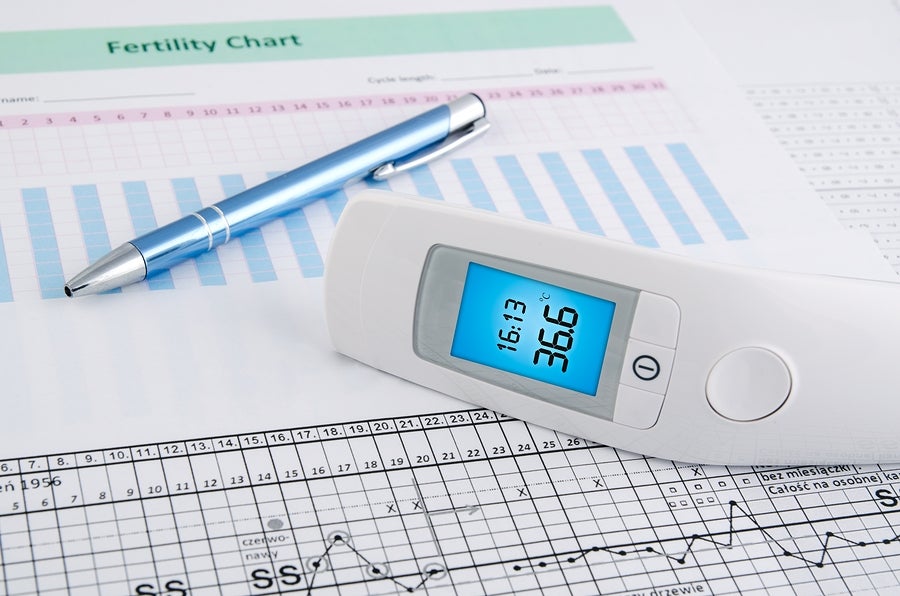Trying to Get Pregnant? Look for These 5 Signs of Ovulation
Uncategorized
Your body has several ways of telling you it’s fertile, from changes in temperature to a heightened sense of smell (perfect for sniffing out all of those sexy pheremones!).
Of course, not all signs of ovulation are accurate enough to help you mark your ovulation calendar, but it helps to know what you should be looking for to determine whether you’re fertile.
So, have you released the egg yet? Look for the following signs:

1. Your basal temperature has increased.
One of the most accurate methods of charting your cycle on an ovulation calendar is to track changes in your basal temperature. But what is basal temperature, and how does taking your basal temp differ from sticking a thermometer in your mouth to check for a fever?
For one, you’ll need different gear.
Basal thermometers tend to be more sensitive than the ones you use when you’re sick — ovulation will only raise your basal temperature by about half of a degree Fahrenheit. You can find basal thermometers at your local drugstore for around $10-$15. (While you’re there, don’t forget to pick up some sperm-friendly lubricant!)
Secondly, you need to be pretty exact in the method you use to take your basal temperature.
To take your temperature, you’ll need to use your thermometer before you do anything else, so don’t reach for your alarm clock just yet.
Mark down your temperature on each day of your cycle, and you should notice an increase in the second week, consistent with the surge in progesterone that comes with ovulation. This is a sign your body is warming up to conceive — though it’s up to you and your partner to turn up the heat the rest of the way.
2. Your cervical fluid has changed in consistency.
The best way to plot out your ovulation calendar is to use the symptothermal method — that is, tracking a combination of basal temperature and symptoms.
One of the best symptoms of ovulation to look for is a change in your cervical mucus.
While it might not sound super sexy, paying attention to when your cervical fluids become clear and stringy, with a consistency similar to that of raw egg whites, can help you tell if it’s time to make babies. The change in your mucus creates the perfect environment for your partner’s sperm to swim to the egg (which is why, if you’re using lubricant, it’s important to use a product formulated to mimic the viscosity of your natural fluids).
The easiest way to check your fluids is to observe your toilet paper after going to the bathroom. You can also check your cervical mucus internally by pressing gently on your cervix. Make note of any changes on your ovulation calendar to get a more accurate read of when you’re fertile.

3. You may experience some cramping (mittelschmerz).
“Mittelschmerz” is a word that sounds much more fun than it is to experience!
Some women may experience pelvic pain on one side or the other during the middle of their cycle. This happens when the egg you release either ruptures a follicle on its way out of the ovary, causing pain and irritation, or when the ovary is stretched. This doesn’t happen to every woman who experiences ovulation, however, so an absence of pain doesn’t indicate a lack of fertility.
4. Your cervix itself is positioned higher in your body.
Did you know that throughout your cycle, your cervix will change both in position and in firmness?
(This is good information to know when choosing a sexual position!) During ovulation, your cervix is positioned higher inside of your body, and it is softer to the touch. During your cycle, your cervix will move further down until menstruation, when it will sit in its lowest position and feel much firmer.

5. You’re looking extra cute.
While this certainly isn’t a symptom by which to chart your ovulation calendar, it is thought that women become (even) more attractive during their most fertile time of month.
If your partner is complimenting you more than usual, or if there’s something awesome about what you see in the mirror that you can’t quite put your finger on, it might be time to check the calendar and see if you’re ovulating!
Plotting a More Accurate Ovulation Calendar
It’s never a bad idea to learn more about your body, whether you’re trying to conceive or simply getting to know your cycle a bit better. Whether you use an actual physical calendar or one of the many great fertility apps available for iOS or Android, your fertility calendar will be more accurate the more signs of ovulation you look for, and the better you become at identifying them.
Just remember: as with anything else, there’s a learning curve to plotting an ovulation calendar, so don’t be too hard on yourself in the beginning (especially if you’re not getting pregnant as quickly as you’d like to). With time, the hard work — and, of course, the great sex — will pay off!
Want to learn more? Read How Does Fertility Work and What Affects It? for more vital TTC knowledge.
Images are for illustrative purposes only.
